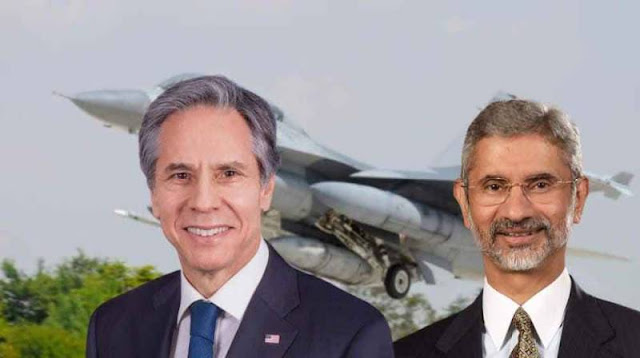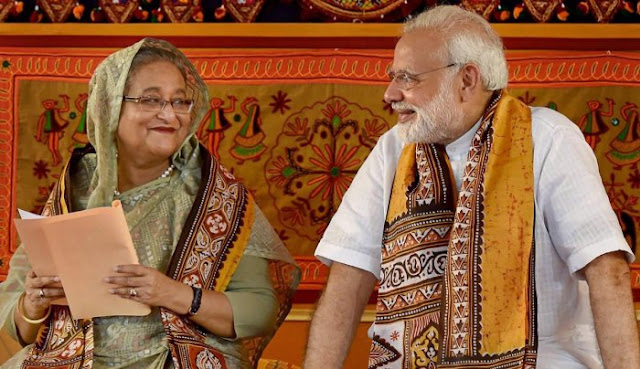“You’re not fooling anybody by saying these things," said Indian External Affairs Minister Subramanian Jaishankar to his American hosts in Washington. He was lashing out at the United States for the State Department's explanation for the $450 million F-16 "sustainment" package sale to Pakistan. Earlier, the US Defense Security Cooperation Agency (DSCA) said in an announcement:
“This proposed sale ($450 million F-16 package) will support the foreign policy and national security objectives of the United States by allowing Pakistan to retain interoperability with US and partner forces in ongoing counter-terrorism efforts and in preparation for future contingency operations.” The US State Department spokesman Ned Price talked about "shared values" and "shared interests" of his country with both India and Pakistan. He also recommended that "these two neighbors have relations with one another that are as constructive as can be possible".
 |
| US Secretary of State Tony Blinken (L), Indian External Affairs Minister S. Jaishankar |
Responding to Jaishankar's outburst, the US State Department spokesman Ned Price said, “We don’t view our relationship with Pakistan, and … our relationship with India as in relation to one another. These are both partners of ours with different points of emphasis in each. We look at both as partners, because we do have in many cases shared values. We do have in many cases shared interests. And the relationship we have with India stands on its own. The relationship we have with Pakistan stands on its own. We also want to do everything we can to see to it that these neighbors have relations with one another that are as constructive as can be possible. And so that’s another point of emphasis.”
 |
| President Joe Biden & First Lady Jill with Pakistani Prime Minister Shahbaz Sharif at the UN HQ |
Indian Prime Minister Narendra Modi recently attended a summit meeting of the China-Russia sponsored Shanghai Cooperation Organization (SCO) held in Samarkand, Uzbekistan. India is a full member of this alliance which has been created to counter the US dominance in Asia. At the same time, New Delhi has also joined QUAD, a group of 4 nations (Australia, India, Japan and US) formed by the United States to counter China's rise. Simultaneous membership of these two competing alliances is raising serious questions about Prime Minister Narendra Modi's real intentions and trustworthiness. It appears that there is an Indian policy shift from "non-alignment" to "all-alignment".
Writing an Op Ed for The Indian Express about Jaishankar's fit of anger, Indian journalist Nirupama Subramanian put it in the following words: “As Delhi demonstrates “strategic autonomy” to engage with every side — Quad one week, and Russia and China the next at the Shanghai Cooperation Organization (SCO) in Samarkand — and work around Western sanctions to buy oil from Russia, and keep friends in all camps, it may have to come to terms that others in world play the same game.”
 |
| US Visa Appointment Wait Time. Source: US State Department |
Jaishankar also raised the issue of long appointment wait times for Indians seeking visas to come to the United States. "In India, there are families unable to meet; students waiting for a long time. So it is a serious problem. But, I'm confident that, with the sincerity Secretary Blinken showed, they would address this, and with any support that we can provide, we hope things will improve," he said. Secretary Anthony Blinken said in response, "We had constraints from COVID about the number of people we could have in our embassies at any one time etc. We are now building back very determined really from that surging resources. We have a plan when it comes to India to address the backlog of visas that have built up. I think you'll see that play out in the coming months."
 |
| US Visa Appointment Wait Time. Source: US State Department |
Related Links:
Modi's India: A Paper Elephant?
Can Washington Trust Modi's India as Key Ally in Asia?
Does Pakistan Need F-16s to Fight Terror?
Ukraine's Lesson For Pakistan: Never Give Up Nuclear Weapons
AUKUS: An Anglo Alliance Against China?
Russia Sanction: India Profiting From Selling Russian Oil
Indian Diplomat on Pakistan's "Resilience", "Strategic CPEC"
Vast Majority of Indians Believe Nuclear War Against Pakistan is "Winnable"





















